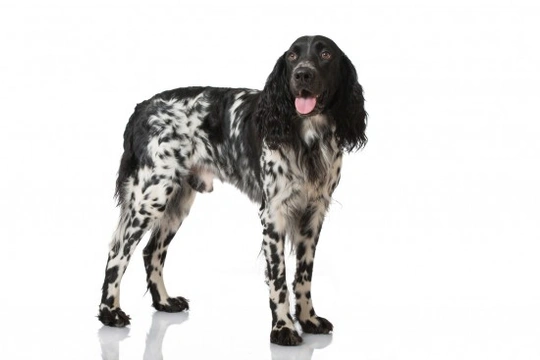
Large Munsterlander dog hereditary health and longevity
The Large Munsterlander dog is a type of gun dog that originates from Germany, but has long been fairly widely distributed across the rest of the world, including within the UK. They are medium to large in size, and a small variant of the breed is also available, classed as a separate breed in its own right.
The large Munsterlander can stand up to 26” tall at the withers, and can weigh up to 30kg, with males tending to be larger than females. They are athletic dogs that should be muscular without being heavy, and have a balanced, elegant and noble appearance.
The Munsterlander coat is black and white, thanks to the presence of the gene for piebald colouring, which means that the amount of each colour across the coat can be very variable. They may be either predominantly white or black, either with solid patches of colour, or with roan colouration, or ticking. The coat is medium length, and sleek and firm in texture.
While the Munsterlander was originally bred as a working dog breed, they have made the transition to domestic life with ease and are perfectly capable of living within the suburban home, assuming that sufficient provision can be made to provide them with enough exercise. Loving, kind and gentle, as well as being excellent with children, the Munsterlander dog is a very versatile breed that is a good match for owners from all walks of life.
If you are wondering if the Munsterlander is the right choice of pet for you, it is important to find out as much about the breed as possible before committing to a purchase. This includes looking into the general health and lifespan of the breed in detail, which we will cover further within the article. Read on to learn more.
Munsterlander average longevity
The average lifespan of the Munsterlander dog is 12-13 years, which places the breed in the average to slightly higher than normal lifespan across the board of all dog breeds of a similar size. This indicates that the Munsterlander tends to be a robust, fit and healthy dog, which is not prone to suffering from a range of minor ills.
Munsterlander genetic diversity
The coefficient of inbreeding statistic for the Munsterlander dog is 7.7%, which is slightly higher than the ideal of 6.25% or lower that is accepted as the ideal range for pedigree dogs. This indicates that the Munsterlander is subjected to some degree of inbreeding in order to keep the breed viable, but not to a high degree. Munsterlander breeders are advised to reduce the coefficient of inbreeding statistic within their own breed pools where possible.
Munsterlander conformation
The shape and build of the Munsterlander dog is considered to be well balanced and robust, and is not subject to any exaggerations that may prove detrimental to the health and wellness of the dog as a whole. Due to the long drooping ears of the breed, care should be taken to ensure that the ears do not harbour dirt and debris, nor that wax is permitted to build up to excessive levels.
Health tests for the Munsterlander
As a well-balanced, generally fit and healthy dog, the Munsterlander is not considered to be a high profile breed, nor one that is at particular risk of a wide range of hereditary health problems. However, a couple of breed predispositions to certain hereditary health problems have been identified, and as such, The Kennel Club and the British Veterinary Association recommends pre-breeding screening for the following conditions:
- Hip score testing, to identify a propensity to developing hip dysplasia. While no formal figures have yet been collated across the breed as a whole, breeding only dogs with a low hip score is advised in order to ensure the hip health of the breed line.
- DNA testing for a propensity to hyperuricosuria, which causes bladder stones to develop.
Other health issues
As mentioned, the Munsterlander breed as a whole is considered to be robust and fit for life, and not to be a particularly sickly dog or one that is at risk of contracting a wide range of health conditions.
However, as well as the conditions mentioned above, a couple of other health conditions that may be hereditary have also been identified within dogs of the Munsterlander breed, which are listed below.
- Cataracts of the eyes, particularly in old age. However, cataracts are usually operable in order to preserve the dog’s vision.
- A type of alopecia called black hair follicular dysplasia, which can cause the black areas of the coat patches to lose their hair, while the white areas remain untouched.
- Males of the breed have a slight predisposition to osteochondrosis of the shoulder, a condition that develops due to abnormalities in the development of the shoulder bones and cartilage. This can lead to bone inflammation and associated pain.



